I’m often asked as Head of Customer Insight why our customers win more of the major intranet, comms and employee engagement awards than anybody else. Today I’m going to let you into their secret: people.
The ease of building an intranet using Interact is a given. There is very little need for specialist skills or even to involve IT, beyond connecting to third party applications or managing your Active Directory environment. However, there is one killer focus all of these awards winners have which sets them up for success: they ensure their company and its employees are mobilised to ensure success.
If you’re considering how to build an intranet for your own organization and want to to get the people in your business ready, you’ve come to the right place. We’ll look at how this simple model for success can translate into your business with its unique challenges and opportunities.
Have a clear picture of people’s roles and needs within the intranet
One of the foundational blocks when you build an intranet is the roles and responsibilities of those involved.
Creating clear groups will help you understand who sits where within your needs hierarchy. It’s very easy to be led by personalities (particularly strong ones!) so it is critical you understand what type of role people each person performs.
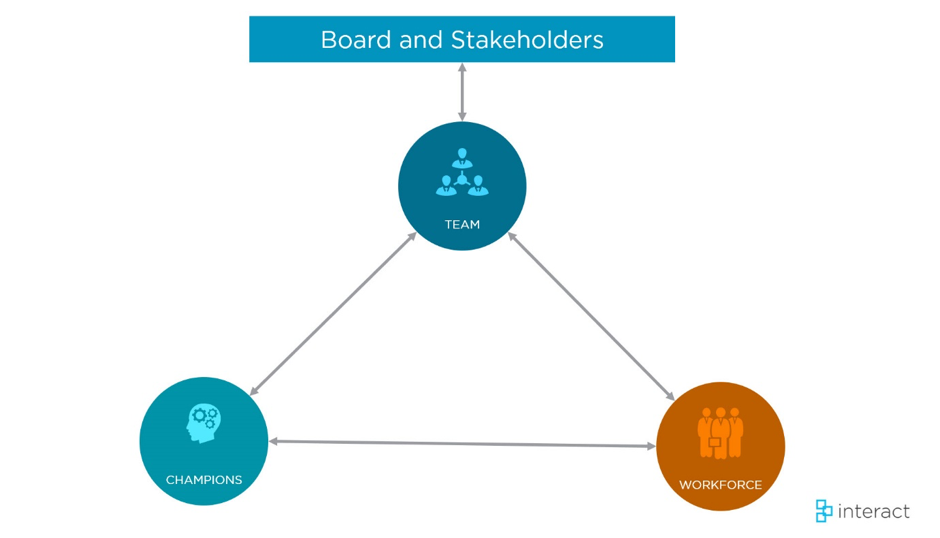
If specific individuals or a group are funding your intranet, or you are reporting the progress of the intranet to them, the chances are these people are the board or your stakeholders. What do they expect and need? What measures do they have to judge the success of your site?
The mission statements section of this blog provides a simple approach to determine this. It is also very important to recognize that this group may not be your everyday typical user, so avoid building an intranet solely around their requirements. You’ll be surprised how many businesses start with this approach and then wonder why their frontline workers aren’t using the intranet.
Next, we have those who are directly responsible for the whole or part of your intranet. This is your intranet team, which we’ll touch upon next.
If people are giving you insight into the workings of their departments, groups or locations, identifying requirements and acting as a cheerleader for your intranet, they are likely to be your champions.
Finally, we have the people using your intranet, who can be broadly referred to as your workforce. Within the personas section of this blog, we’ll look at why it’s critical to define the role types within this.
Who is going to be part of your intranet team?
Surely everyone knows this don’t they? Well, from experience the answer is probably not.
As businesses we tend to know who is going to identify the need for, give sign-off approval of, and undertake the process of building a new intranet. However, the bit where we decide who will be responsible for what within the intranet is one of those important things we plan on getting round to…eventually…this afternoon…one month later…panic!
Firstly, we need to know who is going to run our intranet. This isn’t to be confused with needing an intranet manager and a full time team; less than 5% of our award winners have this level of dedicated resource. If your business is of a certain size, it will undoubtedly help – but it is by no means essential for most.
When we look at our central intranet team, we are trying to understand who will do what within it. Therefore, when you set out to build an intranet, you need to define who will be responsible for a host of ongoing tasks including:
- News contributions from employees
- Ensuring people know how to use the site
- Gathering new requirements
- Engaging stakeholders, their functions and departments
- Encouraging collaboration
Ultimately we’re looking to ensure that “why isn’t this on the intranet?” is a question entrenched across our organizations.
It may well be that these tasks are handled by various people around the business, but typically there needs to be a central person or group who is ultimately responsible for making decisions.
This is something our strategists spend considerable time doing with customers to ensure they are set up for success.
Whilst the people in this group may manage your intranet as part of broader roles, they are likely to see it as an important task and not just something to leave until the last task of the day.
Your central intranet team is separate to your champions, who may be representatives from various employee groups, departments and locations. Whilst your central team is focussed on making your intranet better, your champions are dedicated to ensuring the intranet can solve the most common pain points for their group and act as cheerleaders to encourage the use and adoption of your site.
This central team could be made up of a mix of roles, typically employee engagement or a broader HR role, through to training and comms. However, the beauty of intranet teams is one person may be doing multiple roles or even something completely different to those named.
Selecting Intranet Champions – Think ‘Who do I need?’, not ‘Who is available?’
Intranet Champions are your representatives dotted around the business. They will identify opportunities for the intranet to make improvements to their area and the people using the services of that area, as well as acting as a broader cheerleader about the intranet to their peers. People tend to connect with people like them, so whilst your attempts to engage may be seen as an outsider, someone close to them championing the cause may well receive a greater reception.
For champions to be successful there are two key focuses:
1) You need the right person. Often departments will pick who is available, rather than the best person for the job. This person can sometimes be quite junior or not suited to the role at hand. If you were going to shortlist people within a department / location / group, who would you pick? The trade off to convince managers of this department is to provide resources which will help them drive efficiencies.
2) You need exec and middle management buy in. Do all involved realise the benefit of the intranet and ensure that its work is treated as a critical part of a champion’s role?
If you’ve ever taken the Prince 2 Project Management course, there’s a section where they inform you to ignore people’s availability and pick the resources you need when planning your project. You need the same approach when picking your intranet champions.
A good place to start for champions is to identify the top 5 admin pain points in their area. What are the five questions or actions you consistently have to do via email or phone?
Get your champions to identify the features they feel will be game changers to their teams then encourage them to shout about those features.
Think of your workforce as people
Ok, so we’ve defined our intranet team and have a hoard of champions ready to eulogise around their parts of your business. What about the guys who are actually going to use your site?
It can be tempting to think of your users as one group but really they are an amalgam. If you went on to Amazon and the suggestions for purchases were showing you what somebody in another country, of a different age with varying interests to you was buying, you wouldn’t use Amazon’s recommendations anymore.
When you build an intranet, you need to think of it in the same way. If the intranet looks like it is meant for other people and I’m an afterthought, seeing irrelevant news and functions, why would I bother to use it?
A highly effective way to overcome this is by using personas. Personas allow you to understand not just the breakdown of your workforce but their access to technology, their pain points, their user journeys and also the terminology they use.
Comms practitioners often make the mistake of ‘going corporate’ as a ‘one size fits all’ approach, but if your audiences don’t use the terms you are writing, they won’t use your intranet. Change the tone to reflect the terms they use. This can be particularly effective in launch comms when promoting specific features to specific personas. NSPCC provide a great example of personas:
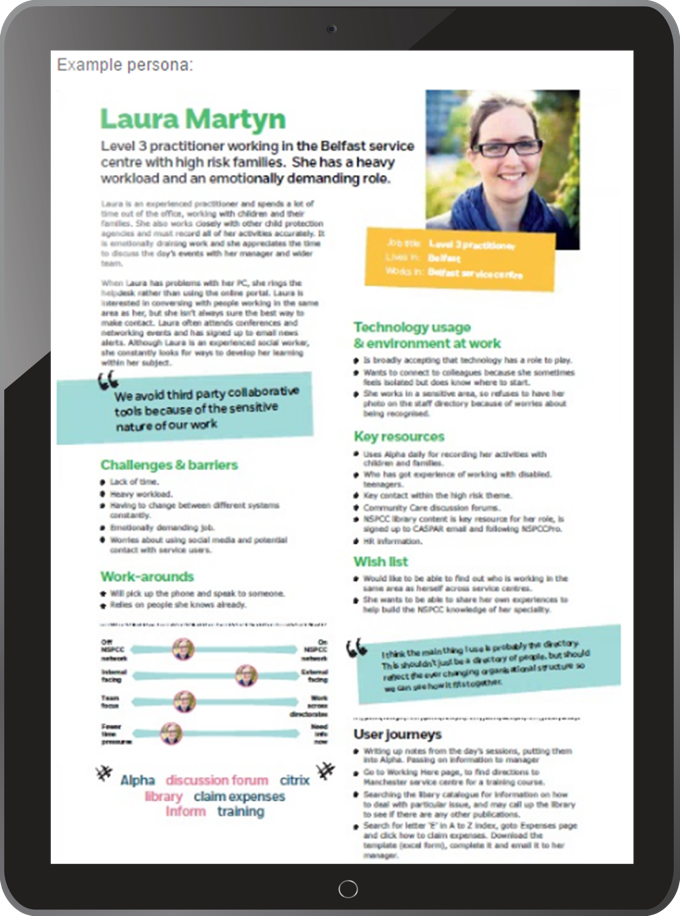
Increasingly we are seeing customers printing out their personas, attaching them to a wall and talking at those personas’ faces to picture how that group would respond to a message or campaign (undoubtedly you’re now picturing how weird this looks, but trust me it works).
A mixture of workshops and surveys will help you gain this information, but nothing beats getting your hands dirty. Engaging firsthand with those who will be using your intranet will not only help you build credibility with front line workers, but also understand howthey work. These workshops will shape any face to face messaging and showcasing you look to do approaching and during launch.
What will the intranet mean to each group?
When you build an intranet, remember that it will mean varying things to various people amongst these groups. We haven’t touched upon middle management, but it’s important to engage and enthuse this group. It can often be picked up in conjunction with your intranet champion work.
Amongst each of those groups, consider what the purpose of the intranet is for them and define mission statements.
For example, you may focus on the measures of success (we’ll touch on this in a little while in this blog):
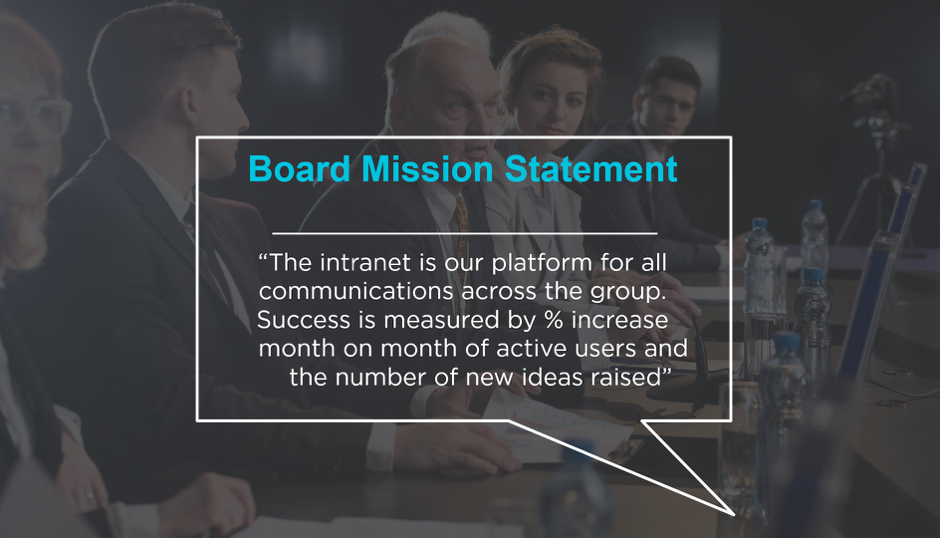
For middle managers, your focus should be on the benefits to them and those reporting:
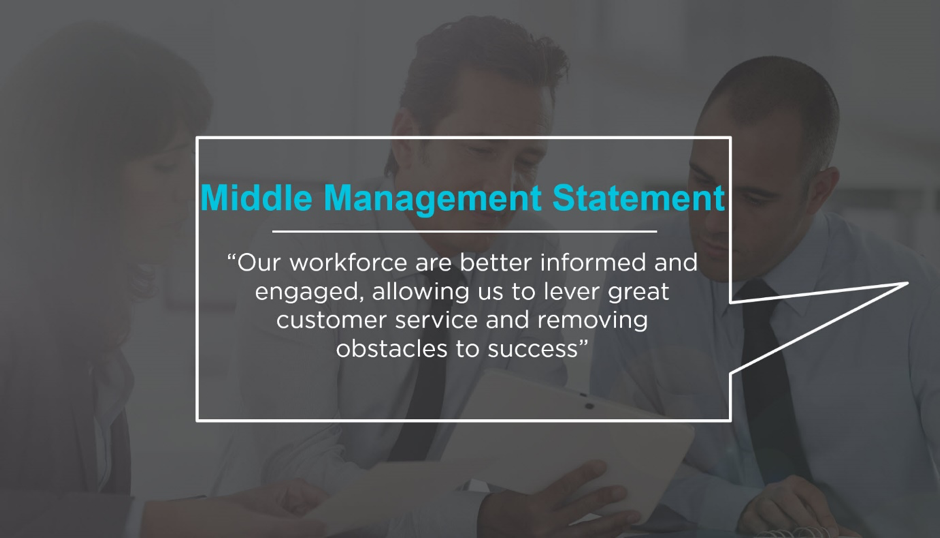
Meanwhile your frontline employees’ purpose will be decidedly different:
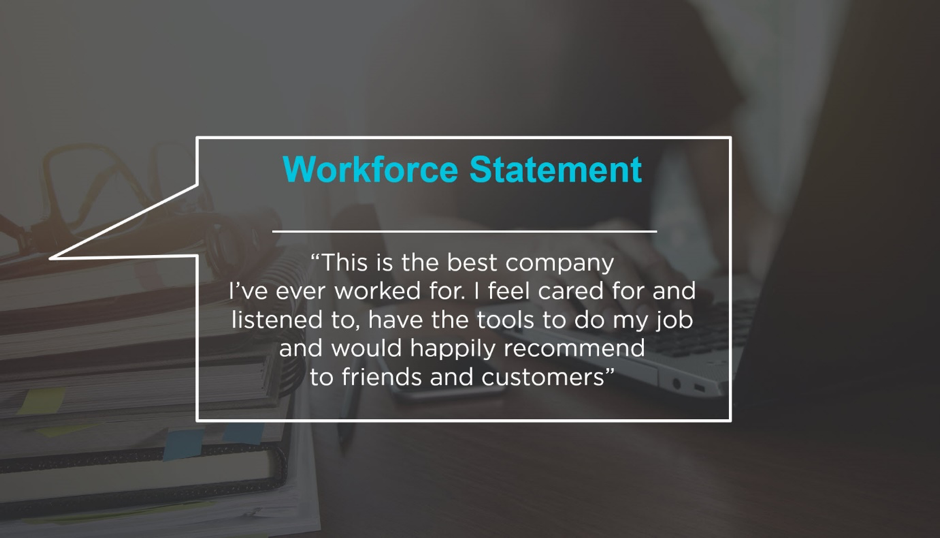
These statements will prove a handy barometer to reflect upon when communicating with, reporting to or working with these groups.
Effectively measuring use and adoption
Once you understand your mission statements, what you should be measuring to ensure you’re supporting those groups will be clearer. For example, simply recording page hits will not mean much to those outside of your central intranet team. Instead, focus on the types of measures your stakeholders will want to see when you report and also focus upon the details which will enable you to judge success and risk areas.
% of active users can be particularly useful if you are building an intranet to be the primary route to self-service and accessing other applications using single sign on. However, this measurement will be even stronger if broken down by the persona groups we identified earlier.
Understanding your intranet’s role in broader business needs
By now you should have a clear understanding of who is required to complete actions and who requires receiving data.
However, there are a lot of activities which will occur outside of your intranet or in conjunction with it. A simple RACI model will help you understood who is responsible for which broad actions, who has an interest in its success, who needs to be spoken to before an action happens and who is the end audience.
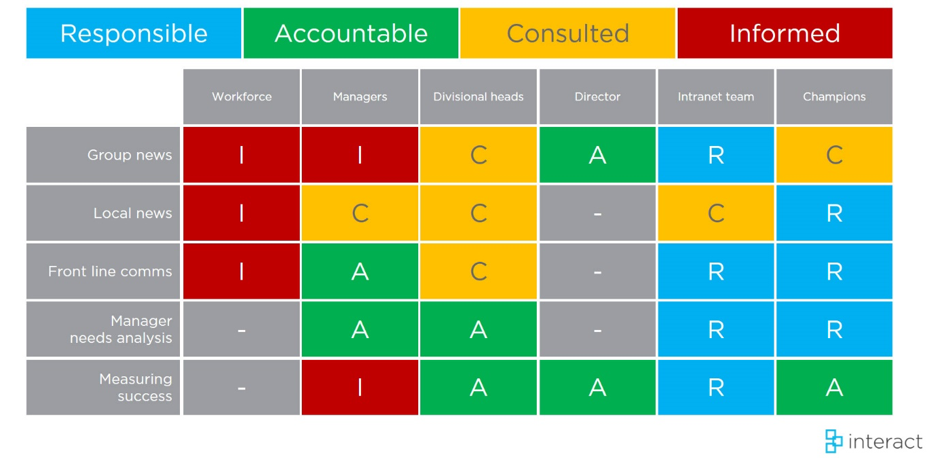
How do you identify and engage the various groups of people in your business?
The process of building an intranet should center on your people. It’s an approach that has seen many of our customers achieve award-winning success, while managing to build an intranet that delivers on every level for their organization.
I’ve purposely kept this guidance broad, but would love to know the approaches you take to make your intranet a success. Share your top tips and ideas in the comments below.




